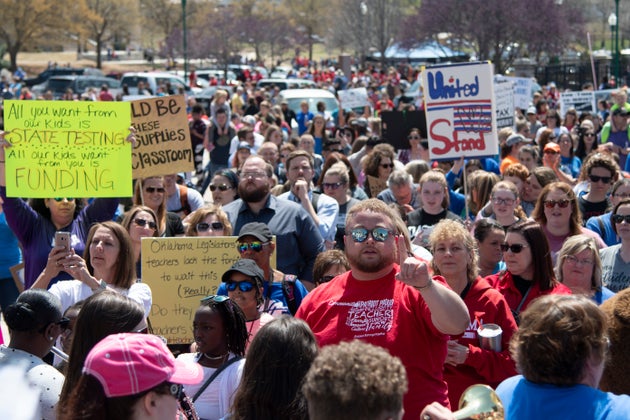
After years of shrinking wages, teachers across the United States are striking back. On Monday, after the historic victory in West Virginia, thousands of teachers in Oklahoma, Kentucky and Arizona went on strike after decades of unfunded schools and low salaries.
There’s bound to be more protests because teacher strikes are just one dimension of the surging economic inequality. For all the government’s talk about the booming economy, hundreds of thousands of public sector jobs have been lost under the regime of austerity. And despite the political class’s attempt to change the subject or shift the blame — from too much regulation to the supposed dangers of immigration — shrinking wages and rising job insecurity remains the reality for most people in America.
American workers have had the longest and deepest fall in real wages since 1979: median compensation has increased by just 8 percent, and nearly all the gains from growth have gone to the top 1 percent. Even though the U.S. labor force is almost 75 percent more productive as compared to the early 70s, pay is still about the same. In fact, a total of 41 million Americans are living below the official poverty line.
When you add in decades of sweeping cuts in benefits, the impact is severe. You can see it in nearly every town and rural county, where the drug epidemic is filling the vacuum, killing more people each year at a startling rate. The Government trumpets the drop in unemployment, but the swelling number of involuntary part-time, self-employed, and low-pay work tells another story.
In this context, it’s no surprise that teachers are starting to get organized. There is of course a long tradition of militancy going back to the “mine wars” and other high points in the history of Appalachian labor strikes. Those workers taking industrial action include former miners who went on strike 72 years ago to defend their jobs and communities against the repressive features of the capitalist state.
And now, West Virginians, similar to the teachers in Chicago six years ago, have shown workers across the country that when you fight back, you can win concessions from the powerful.
But, the recent teacher strikes also underline the role of cuts, not only in extracting wealth from public services, but in driving down pay for those at the bottom end of the labor market. The combination of privatization and austerity is especially toxic — reflected in Trump’s rise to power, surging xenophobic right, and dark money in politics. Which is only a reflection of broader economic failure.
Despite all the talk of recovery, the economy is simply not working for the majority — even if it’s still filling the pockets of the wealthiest Americans. It’s ideologically driven, of course, which has defined the approach of the political establishment for decades. That at least has the advantage of opening up room for social movements to maneuver, and reverse the democratic party’s neoliberal turn that transformed it from the party of the working class to the party of Wall Street.
From the women’s marches, to the Parkland students’ anti-gun protests, to packed town hall meetings, millions of Americans have been seeking out ways to curb what they see as a damaging economic system designed to merely serve a tiny minority. In the process, they’ve begun to lay the foundations for a new era of grassroots activism that’s becoming one of the silver linings of the Trump era.
Overcoming the crisis in living standards demands a radical platform of public programs and investment, not stale politics. This week’s strikes — and the recent teacher’s strikes — offer a chance to shift the fundamental political focus from Washington’s soap opera to the crisis the majority of working people actually face. It’s teachers, health care and public service workers who represent real America. Their battle is our battle.